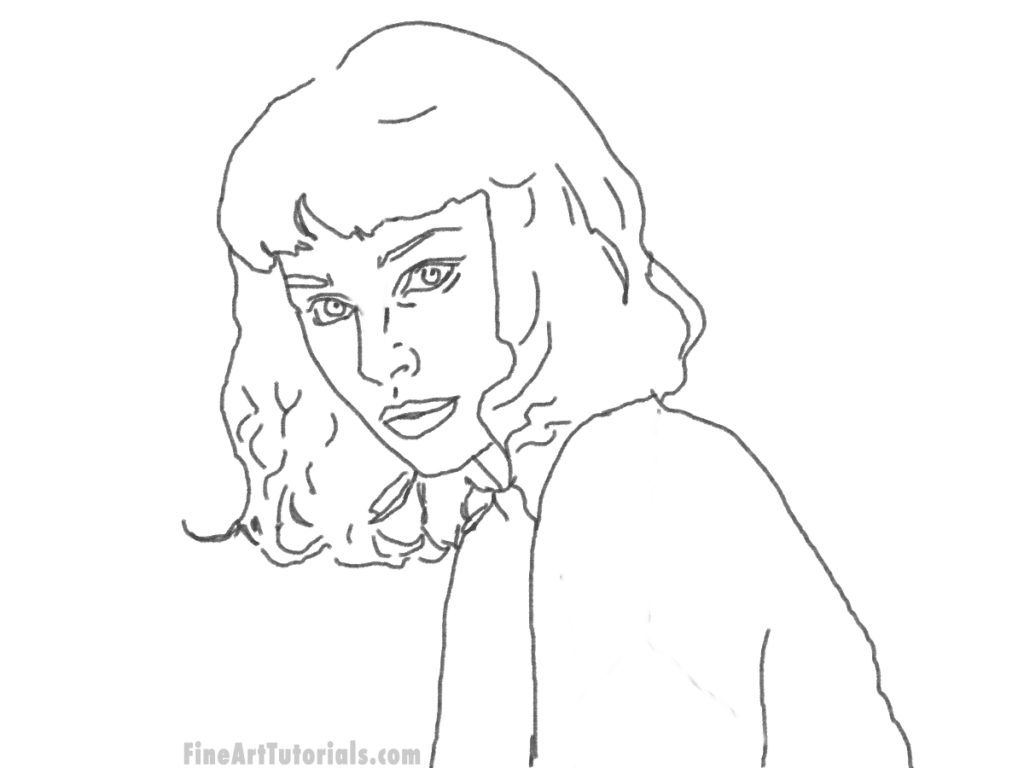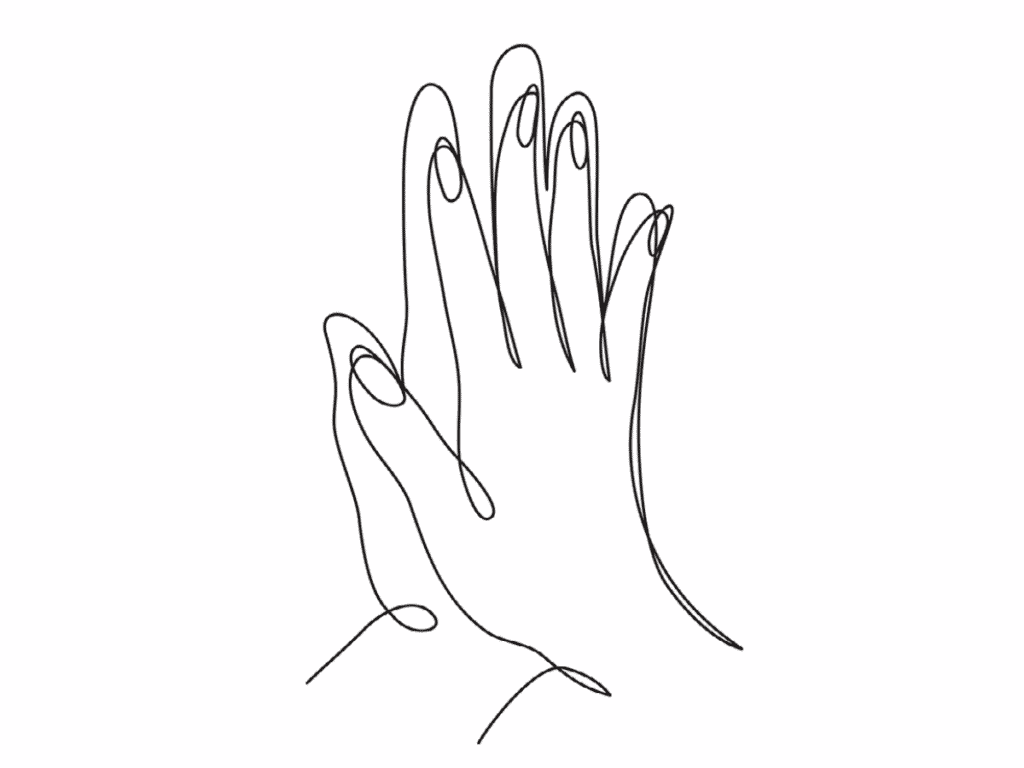Contour drawing is a type of line art drawing technique that uses line to create the illusion of three-dimensional form. The artist begins by drawing the outline of the subject, outlining the main features and details.
Contour drawing can be used to capture the essence of a subject with few lines, making it ideal for quick sketches. It can also be used to create more detailed and complex drawings.
Disclaimer: Fine Art Tutorials is a reader supported site. When you make purchases through links on this site, we may earn a small commission at no extra cost to you.
Contour drawing definition
A contour drawing is a drawing technique, whereby the artist outlines the shape and mass of an object or subject. The main details and features are outlined, but small details and value transitions are omitted. In a contour drawing, the artist aims to represent the ‘contours’ and edges of the form accurately, without portraying volume or depth by shading the light and shadows.
Contour drawing exercise

Contour drawing is a great drawing exercise artists use to improve their skills. Because contour drawings rely on accurate proportions, it can be used to train artists’ abilities in rendering space, form, mass and distance. This relies on analysing the reference, then portraying features of the subject or object with just line, so that it appears recognisable to the viewer.
Contour drawing can also be used to create more expressive and gestural drawings. This is where the artist exaggerates or simplifies the forms to express their own interpretation. This can result in some interesting and unique drawings!
Contour drawing tips

- Use a light touch when starting out. You can always go over the lines more boldly later if you need to.
- Look at your subject and mentally break it down into basic shapes. This will help you to simplify the forms when drawing them.
- Remember, you don’t have to draw every single detail! Just focus on the main features.
- Pay attention to the negative spaces around and between the objects. These can be just as important as the objects themselves.
- Practice, practice, practice! The more you contour draw, the better you’ll become at it.
How to create a contour drawing

Now that you know what a contour drawing is, and have some tips on how to create one, why not give it a try? All you need is a pencil and paper.
Once you’ve chosen your subject, take a look at it and break it down into its constituent shapes. Look at the space between features and try to roughly measure the distance with your eyes.
Begin by drawing the outermost shape, then move onto the smaller shapes within it. Trust your instincts and take time to analyse your reference. This is an exercise in precision, so try your best to accurately draw the proportions of your subject, without aids.
Once you have the full outline of your subject, you can always take it further and shade the highlights and shadows if you like how it turned out. Optionally artists can use other drawing techniques like hatching, cross-hatching, or other line techniques to add volume and depth.
Benefits of contour drawing
Contour drawing is a great way to improve your skills as an artist. It can help you to better understand and draw the forms around you, and train your eye for accurate proportions. The exercise can also be quite therapeutic, as it requires concentration and focus.
Plan composition with contour drawing
When beginning a new painting or drawing, some artists start with a contour drawing first. This allows them to plan the composition of their work, and decide on the placement of the various elements. By doing a simple contour drawing, they can avoid getting bogged down in details too early on, and make changes more easily. By exercising this skill, you will be able to draw and paint with more accurate proportions when using other media and when creating larger final pieces.
Examples of contour drawings
Two artists that are both famous for creating captivation contour drawings are Picasso and Egon Schiele.

The portrait of Igor Stravinsky, 1909 by Picasso is an excellent example of how the artist used contour drawing to create a recognisable likeness, without resorting to shading or other volume-creating techniques.

Egon Schiele’s sketches are well known for their raw and emotive qualities. In this portrait of a woman from 1908, the artist has exaggerated her features to create a more expressive image. Schiele often used contour drawing in this way, to capture the gesture and feeling of his subjects.

As you can see, there are many different ways that contour drawing can be used. By practicing this skill, you can develop your own unique style and approach to creating artworks!
Other types of contour drawings
Continuous line drawings, gesture drawings and blind contour drawings are all types of contour drawing.

A continuous line drawing is one where the artist doesn’t lift their pencil from the paper, resulting in a single, uninterrupted line. This can be a challenge, as it requires you to plan your composition carefully before you start drawing. However, it can also lead to some interesting and flowing results!

Gesture drawings are usually done quite quickly, and are used to capture the overall movement or gesture of a subject. They are often used by artists as a way to warm up before starting a more detailed drawing.
Blind contour drawings are similar to contour drawings, in that the artist draws an outline of the subject. However, with blind contour drawings, the artist doesn’t look at the paper while they are drawing. This can lead to some wonky and amusing results, but it’s a great way to loosen up and have fun with your drawing!
Supplies to create a contour drawing
All you need to create a contour drawing is a pencil and a piece of paper. However, other drawing supplies such as erasers and pencil sharpeners can also be useful. As contour drawing is a drawing exercise, many artists will opt to practice in a sketchbook. Keeping a sketchbook is a great way to log improvements over time, it’s also a great place to let loose and just draw, without fear of judgement or messing up.
Contour drawings made with ink can look quite effective and can make for excellent final pieces. If you’re interested in trying this, all you need is a pen and some marker paper. Fountain pens or markers are a good option, as they will produce a consistent line.
Finally
Contour drawing is not about getting every line perfect, it’s about capturing the essence of the subject. So don’t worry if your lines are imperfect, or if you don’t quite capture everything you see. The important thing is to have fun and to experiment with line.
There are no rules when it comes to contour drawing, so just go ahead and give it a try!
If you interested in improving your drawing skills, we’ve released a free eBook that you can download in the guides section when you join our Facebook Group. Our group is a space for artists to share their work, so feel free to share your drawings when you join! We’d love to see your results.


